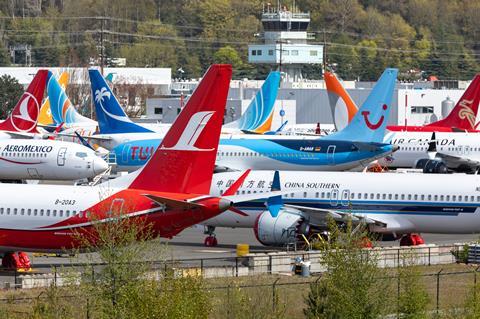The US government’s criminal case against Boeing rested on the actions of just two Boeing employees who prosecutors say conspired to defraud the US government.
That fact, and the size of Boeing’s actual fine for its role in the 737 Max disaster, has some aerospace analysts noting that larger issues might remain unaddressed.
“I’m far from thrilled that, rather than actually talking very much about changing the company’s culture… there is simply the insistence that a couple of pilots bear the burden of the blame,” says Teal Group analyst Richard Aboulafia.
The US government says on 7 January that Boeing agreed to pay $2.5 billion to settle a “fraud conspiracy” related to certification of the 737 Max.
Two Max crashes – in 2018 and 2019 – killed 346 people, spurring a global grounding and numerous investigations.

“The Boeing Company knowingly and willfully, and with the intent to defraud, conspired and agreed together with others to defraud the United States,” says the US Department of Justice’s (DOJ) complaint against Boeing, filed 7 January in US District Court for the Northern District of Texas.
Boeing’s actual criminal penalty comes to $244 million, about 10% of the total $2.5 billion settlement.
The balance includes $500 million to be paid to relatives of crash victims and $1.77 billion to compensate airlines for delayed deliveries.
“The actual [fine] is 10% of the headline,” Aboulafia says, noting Boeing had been expected to compensate airlines and relatives anyway. “The rest seems suspiciously placed to make the headline bigger.”
The DOJ based its case on actions of two Boeing employees, both flight technical pilots.
Prosecutors allege those pilots misled the Federal Aviation Administration’s Aircraft Evaluation Group (AEG) about the Max’s Maneuvering Characteristics Augmentation System (MCAS). The FAA’s AEG establishes pilot training requirements.
Boeing added MCAS to the Max to counter the jet’s tendency, due to its larger engines, to pitch nose-up during certain flight circumstances. MCAS pitches the nose down. Both crashes were preceded by MCAS malfunctions; the pilots were unable to recover.
Around November 2016, two Boeing flight technical pilots “discovered information about an important change to MCAS”, the DOJ says.

Those pilots did not share their knowledge of the changes with the FAA. They “concealed this information and deceived the FAA AEG”, the government says. “Because flight controls were vital to flying modern commercial airplanes, differences between the flight controls of the 737NG and the 737 Max were especially important to the FAA AEG.”
The DOJ does not name the two pilots.
But in previously released emails, former Boeing technical pilots Patrik Gustavsson and Mark Forkner discussed concerns with MCAS. Neither man’s attorney responded to requests for comment.
“Because of their deception, a key document published by the FAA AEG lacked information about MCAS, and in turn, airplane manuals and pilot-training materials for US-based airlines lacked information about MCAS,” the DOJ says. “Pilots flying the 737 Max for Boeing’s airline customers were not provided any information about MCAS.”
The FAA’s AEG only learned about changes to MCAS after the first crash – that of a Lion Air jet on 29 October 2018.
DOJ investigators were initially “frustrated” by Boeing’s slow response to its requests for information, the government says, adding that Boeing fully cooperated six months into the inquiry.
Analyst Michel Merluzeau with consultancy AIR suspects the settlement will help Boeing put a troubled chapter in the past.
“There is a sense of finality,” he says, noting Boeing has also restarted delivering Max after the FAA certificated the jet in November.
Still, analysts believe outstanding safety issues remain .
Merluzeau thinks the FAA’s oversight and certification function must be strengthened to close gaps. A law passed in late 2020 aims to do just that. It requires a review of the FAA’s Organization Designation Authorization, the process under which the FAA allows manufacturers to perform some aspects of certification.
Aboulafia does not believe that the Max disaster stems from actions of just two pilots.
“It seems to be that the causes of this accident are complicated”, involving company culture, management and oversight, he says.



















